My first news of the Palisades fire came from a message in my neighborhood WhatsApp group. I learned from my neighbors in Del Rey that a blaze had broken out in the hills — above the neighborhood I grew up in, where my parents still live in our family home on the edge of the Palisades.
My own neighborhood of Del Rey was likely out of harm’s way. Yet as we all learned how quickly the fire was spreading, the neighborhood WhatsApp transformed into a mini resource center, sharing tips for staying safe and volunteering spare bedrooms and ADUs. A call for available deep freezer storage for an evacuee’s breast milk was met with offer upon offer. Everyone made space.
Meanwhile, I commiserated with preschool-era friends as our parents fled the Palisades and the institutions that raised us lit up in flames. The library, the grocery store, the coffee shop where I’ll always remember parking on the couch with my best friend discussing “1984” for hours — all gone. Was our synagogue OK? Nobody knew.
My parents evacuated to my mother-in-law’s house, friends scattered around Los Angeles. We all woke up to learn that so many families, dear friends, had lost their homes — each piece of news a gut punch. Even the famous village shopping district at the center of town was ash.
The devastation my community experienced was also being felt across L.A. County. The Eaton fire in Altadena burned tens of thousands of acres, including artist studios, musical havens and important sites of Black Angeleno heritage. The Hurst fire threatening Sylmar. Other fires dotted the L.A. map throughout the week, spurring evacuations and fear for West Hollywood and the West Valley.
Fire had reached into and across the city, taking, at this time of publishing, 28 lives and more than 16,000 structures. Meanwhile, despite heroic firefighting efforts, other government bodies sowed confusion. Our leaders have been playing a political blame-game. Past decisions to deprioritize fire prevention are coming to light. Even our emergency alert system failed, frightening every resident with a smartphone who received an evacuation notification sent in error.
The same day that the fires broke out, outgoing United States Surgeon General Vivek Murthy released a parting statement. The nation’s top doctor had spent his two terms interviewing citizens across the country learning about what contributed to and detracted from their mental and physical health. From his research came a prescription: A nation plagued with heart disease, diabetes, depression and an addiction crisis was — more than anything else — in need of community.
“The fracturing of community in America is driving a deeper spiritual crisis that threatens our fundamental well-being,” Murthy wrote, calling for a radical shift “in how we build and prioritize community.”
Witnessing how Los Angeles’ community networks picked up the slack of institutions that failed us illustrated the urgency of Murthy’s message. This prescription needs to be filled.
Disaster throws the need of community into sharp relief, but it is crucial for everyday and lifelong health and well-being too. Murthy explains that the “three pillars” of community — relationships, service and purpose — are scientifically proven to positively impact both life expectancy and life satisfaction.
These pillars, Murthy says, can “significantly influence health outcomes, including premature mortality, heart disease, depression, and anxiety. Community also gives us strength and resilience when facing the big challenges and countless paper cuts that come with moving through the world.”
But, as he sees it, these pillars have crumbled in recent years. An increase in the amount of time people need to spend at work has meant less civic participation and social interaction. The pandemic and social media both led to isolation, with the latter sowing division as discussions moved from in-person to online. Just 30% of people do volunteer work, and over 60% of young people say they feel directionless.
The path to building community through these three pillars will take both individual effort and government investment, explains Murthy. Deepening relationships requires interactions that go beyond the group-chat, and fostering empathetic schools and workplaces. Providing service means the willingness to lend (and ask) a neighbor for help. Finding purpose means access to education and resources that unlock meaning in addition to a paycheck. The foundation for it all is reinvestment in (gutted) community infrastructure and social services that enable people to do more than simply survive.
Community is a cornerstone of both individual wellness and collective well-being in the best of times. Now, friends, neighbors and an army of Los Angeles volunteers are proving community is a powerful tonic in the worst of them.
After the fires swept through the Palisades we learned that, in some Hanukkah-esque miracle, my family’s Pacific Palisades synagogue, Kehillat Israel, did not burn, even as homes on its block did. In the coming days, KI became a locus of support, both practically and emotionally. It held both in-person services in a space lent by a temple across town, and a Zoom webinar. Local officials and disaster recovery experts gave concrete advice and information, and clergy and congregants gave each other time and space to hold each other’s pain. Even the Early Childhood Center found a temporary space for its toddler Shabbat group, Tot Shabbat, so that the temple’s youngest members could still see and sing with their class while evacuated from their homes. It’s been clear that bearing the grief with lifelong friends and strangers alike is the only real thing we can hold onto for the “strength and resilience” Murthy speaks of at a time like this.
Angelenos throughout the city have leaned on one another for support too. The essential workers who have lost steady employment in Palisades and Altadena homes are finding new opportunities in neighborhoods where residents share the names of those looking for work, like in my neighborhood group chat. A GoFundMe for organizations advocating for essential workers has raised over $90,000. For people seeking ways to help in person, every day, Mutual Aid Los Angeles Network updates a Google spreadsheet of volunteer opportunities that has dozens if not hundreds of viewers at all hours of the day and night; volunteer centers are so busy that they are turning people away. Teenage organizers are full up on beauty supply donations for other teenagers affected by the fires. Real estate agents are providing free house-hunt services, salon workers free haircuts, restaurants free meals and so much more. Celebrities like Beyoncé have given millions toward relief and recovery efforts; the general public has raised $50 million for those affected by fires on GoFundMe alone.
All of these efforts are only possible because Angelenos decided to care about one another. The fires have shown that our city, a patchwork of neighborhoods, is also a collection of neighbors.
This overwhelming community response to a crisis may be helping to cushion the blow for some, to the extent that that’s possible in the face of catastrophic loss. But community cannot only be a reactive value. On a national level, enshrining community as a civic value and way of life must serve as a local bulwark against natural disaster and larger political forces. On an individual level, seeking out community, and inviting others in, can ensure support in the face of both big challenges and “paper cuts.” Whether that’s being part of a faith institution, or participating in or creating a communication hub like a neighborhood chat. Local clubs and volunteer opportunities can help you bond with your neighbors over common interests. In all these cases, community is quite literally a lifeline.
That’s why the fires have made clear that building, investing in and nurturing community is important not just now, but always.
On Wednesday Jan. 8, one of KI’s rabbis, Rabbi Daniel Sher, recorded and posted a video on Instagram after finding out that he had just lost his own Palisades home:
“Our community that we love so dearly is in disarray,” he said. “But I do know that we will care for one another, reach out for one another, and we will rebuild. So many of us are experiencing heartbreak. But when a community experiences heartbreak together, it means that we can mend our hearts together as a community as well.”
As Murthy says, “a community grounded in love is a community that will stand.” It’s that human-to-human connection and compassion that will help us weather the storm. Every text I sent and received to impacted friends I’ve known since our KI preschool days — some of whom I haven’t even talked to in years — contained those words: I love you. Those bonds, and the ones we’ve seen form and tighten throughout the city, give me hope that when it comes to healing from these fires, Los Angeles is poised to administer our former surgeon general’s cure.
The post The Surgeon General’s parting prescription? Community. Amid the fires, L.A. is filling it appeared first on Los Angeles Times.


















